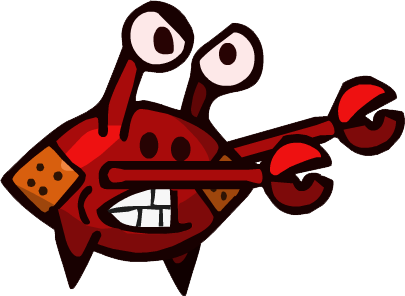

When a crab molts, a crack forms along the shell and then the crab backs out of it. When a grab gets bigger, it must climb out its shell in a process called molting. A crab’s shell does not grow or stretch.Crabs can live on land as long as they keep their gills moist.A crab may lose a claw or leg in a fight.Crabs have several predators, including seagulls, sea otters, octopuses, and humans.They are usually not picky eaters and will eat bits of dead plants and animals, algae, worms, detritus, or other crustaceans. The stalk helps a crab see while hiding under water, rock, coral, sand, or mud. Eyestalks can move in different directions and allow a crab to see all around. Crabs have eyes that are set on eyestalks.Just 2–3 ounces of crab meat will supply an adult with the daily B12 requirement. Crab meat is very high in vitamin B12.Crabs make up 1/5 of all creatures that are caught from bodies of water around the world. Humans eat about 1.5 million tons of crab every year.People consume about 1.5 million tons of crab annually The Japanese Blue Crab or the Horse crab is the most consumed crab in the world.These living decorations not only camouflage the crab, but the anemones’ stings also discourage predators. Some crabs, such as the spider crab, disguise themselves by attaching living things, such as anemones, to their bodies.Pea crabs are the smallest of all crabs and, not surprisingly, are about the size of a pea.True crabs can walk slowly in any direction, but when they need to hurry, they usually move sideways.Consequently, scientists say crustaceans should be treated with the same care as vertebrates. While early research declared that crabs feel no pain, new research suggests crabs not only suffer pain but they also remember it.Crabs are crustaceans (have an exoskeleton) and arthropods (have segmented appendages).

They also live under the ice in Antarctica. They are found almost everywhere in the ocean, including smoking volcanic vents thousands of feet below the surface. Crabs live in more different places than any other sea animal.red rock) crab is the most colorful crab in the world. All crabs have maxillipeds and other paired structures on their heads that are used for feeding.A hard shell called a carapace covers a crab’s body.The small boxer crab carries a pair of stinging anemones in its claws as protection.They can also be used like chopsticks to pick up food. A crab can use its claws as a vice for crushing or like scissors for cutting.Crabs have large compound eyes made up of hundreds of tiny lenses.All crabs have one pair of pincers (chelipeds) and four pairs of walking legs.All crabs have claws on their two front legs.Crabs are also known as “ spiders of the sea” because, like crabs, spiders have legs that bend at joints.The other 500 types are false crabs and include hermit crabs, king crabs, porcelain crabs, horseshoe crabs, and crab lice. There are about 5,000 species of crabs.False crabs include hermit crabs, king crabs, and squat lobsters. Second are false crabs, or anomurans, which have a longer abdominal section and fewer walking legs. True crabs include blue crabs, spider crabs, and ghost crabs. First are true crabs, or brachyurans, which have a very short abdomen and use four pairs of long legs for walking. They have hardly changed since the age of the dinosaurs, and their closest-living relatives are spiders. Instead, they have their own separate class named Merostomata. Horseshoe crabs are often called "living fossils"


 0 kommentar(er)
0 kommentar(er)
